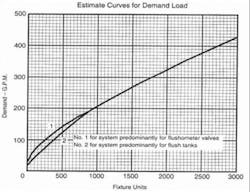ATLANTA — There aren’t many assemblies of plumbing geeks larger than gathered here at the American Council for an Energy Efficient Economy Hot Water Forum. The best minds in plumbing contracting, engineering, manufacturing, national laboratories, public utilities, plumbing codes, and academia came together to talk about the best ways to heat water, use water, and minimize water waste.
Part of minimizing waste is an effort by plumbing code experts to revise the legendary Hunter’s Curve, created by Roy B. Hunter in 1940 for the U.S. Department of Commerce. Hunter considered a plumbing fixture’s water flow, duration of flow, and the probability that it would be in use, explained Steven Buchberger, an engineer from the University of Cincinnati who sits on a committee considering revisions to Hunter’s Curve for the International Association of Plumbing & Mechanical Officials.
Hunter, for example, would consider a bank of toilets and calculated the 99th percentile probability that multiple toilets would be flushing simultaneously. In a bank of seven toilets, that number is between four and five. Hunter created curves for banks of toilets and their GPM flow and did the same for lavatories. Because each fixture has a different flow rate, Hunter converted them into a common value, fixture units, and placed those fixture units into his Hunter’s Curve.
“It’s simplicity is seductive,” Buchberger said, but it’s also way too conservative and greatly oversizes supply and waste lines.
Buchberger sits on an IAPMO sub-group that is working on predicting residential plumbing fixture demand. The group is looking at six residential fixtures, including toilets, showers, tubs, faucets, dishwashers and clothes washers. The group will attempt to determine pulse intensity, duration and frequency.
Field studies show that Hunter’s Curve greatly over-predicts the probability of simultaneous use, said another speaker, Yanda Zhang of consulting firm TRC Companies Inc. The reference flow rate for the table, Zhang pointed out, it a flush valve with a fixture unit value of 10 and a flow rate of 27-GPM.
To illustrate his point, Zhang showed the curves used to size pipe based on friction loss and velocity. Using both methods, the user technically would have to keep going up to the next size of pipe, and the chart indicates that individual residential fixtures should be served by ¾-in. pipe.
Use of WaterSense faucets and fixtures, LEED building, and the Home Energy Rating System means that plumbing fixtures currently in use need much less water than called for by Hunter. Once that amount is determined — Buchberger said the result may be expressed in actual GPM and fixture units might be discarded — the next step will be selling it to homebuilders and building owners.
Craig Selover, Selover Consulting and formerly with MASCO Corp., parent of Delta Faucet, said that homebuilders have been receptive to the HERS program because they can use it in their marketing. If reduced water usage can be worked into the HERS program, Selover said, that might make the builders receptive to actually engineering plumbing design and insulating pipe. Currently homebuilders are indifferent to how water gets to the fixtures.
